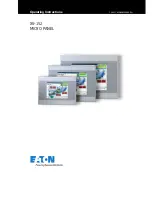
© ADB Airfield Solutions All Rights Reserved
35
Insure that a new anti-vibration washer is used with each new bolt. Anti-vibration washers
are effective in preventing bolt loosening caused by high dynamic loads. See Figure 23.
Anti-vibration washers consist of a pair of unique washers. There are stepped cams between
the face of washers that is greater than the pitch of the bolt. The rise of the cams creates
tension that positively locks the bolt.
Figure 23:
Anti-vibration washer
Always use a new anti-vibration washer. Never reuse an existing anti-vibration washer.
Recommended stainless steel anti-vibration washers are:
•
Heico Part Number HLS-3/8” SS [ADB part number ACC0375]
•
Nordlock Part Number NL 3/8 SS
Insure that the anti-vibration washer is installed properly. An anti-vibration washer consists of
two halves. Insure that the stepped cams between the face of washer halves face each other
(see Figure 23). The pair of washers are typically glued together for easy assembly to the
bolt. Never use only one part of a 2-part anti-vibration washer. The outside of the each
washer half has serrations that grip and seat the mating surfaces. Never reverse the halves
such that the serrations face each other.
If anti-seize (lubricant) is used on the bolt, the following products are recommended:
•
Loctite LB 8009™ Heavy Duty Anti-Seize. This is also available in stick form as Loctite
LB 8070™ Heavy Duty Anti-Seize Stick.
•
If the airport is located in a more corrosive environment, such as an airport located by the
ocean, use Loctite LB 8023™ Marine Grade Anti-Seize.
If a threadlocker is used on the bolt, the following is recommended:
•
Loctite 243 Removable Strength Threadlocker.
Consistency of use of anti-seize or threadlocker is important. If anti-seize was previously
used on a base can, completely clean out the base can threads before applying threadlocker.
Also, it is good practice to blow out or remove any loose threadlocker residue before applying
new threadlocker.
See Figure 24. It is recommended that the bolt coating be applied in three locations:
•
Under the top of the bolt head.
•
In the area underneath the bottom of the anti-vibration washers that contacts the in-
pavement fixture.
•
The entire area of the bolt thread that attaches to the base can.
Applying a coating in these areas reduces the friction that occurs that resists the bolt from
achieving sufficient clamping force. It is not recommended to install the bolt dry (i.e., with no
coating).
















































